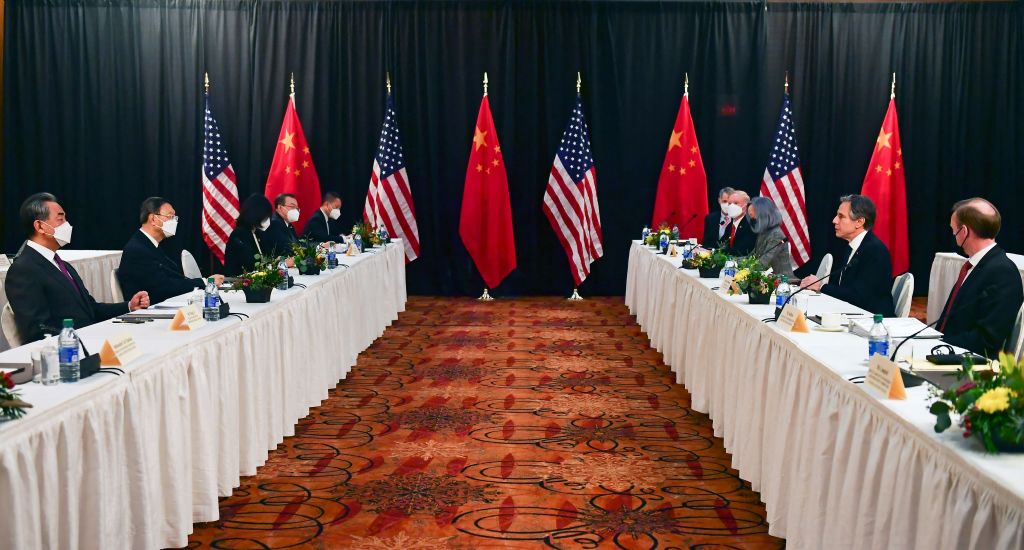
Last week’s meetings in Alaska constituted phase two in high-level US–China contact under the Biden administration. And it was consistent with phase one—Joe Biden’s phone call with Xi Jinping in February. Beyond the histrionics are some deep messages for how Team Biden is working with allies and partners, with important implications for Australian policy and action.
It’s very clear now that any dewy-eyed hopes Beijing had that Biden was going to be Barack Obama Mark II and work desperately to be collegiate with Beijing despite a lack of reciprocity are gone. President Biden is a changed animal to the Obama-era vice president.
It must also be clear to the US leadership and to partners and allies from Brussels to London, New Delhi, Tokyo, Seoul, Taipei, Hanoi, Ottawa and Canberra that any early positive ‘reset’ of core Chinese policies by General Secretary Xi with the end of the Donald Trump era is also simply not happening.
In a big shift from Trumpian approaches, though, the US—through Secretary of State Antony Blinken and National Security Advisor Jake Sullivan—came to the table after engaging with key partners and allies. Blinken was returning from Japan and South Korea, and he had the knowledge and momentum out of Biden’s first Quad leaders’ meeting with the prime ministers of Australia, India and Japan.
So, the US teleported its allies’ and partners’ interests and weight into the room, with Blinken using the early part of his opening statement to tell Beijing’s attending diplomats that the Chinese government’s economic coercion of US allies—think Australia—had to end for there to be forward movement. That’s a newly forthright identification of allied economic interests as strategic issues, which is big news in the US alliance network and has serious, if mainly positive, implications for Australia and other US partners.
In contrast, China’s two top diplomats, Yang Jiechi and Wang Yi, could only bring the Chinese government and the Chinese Communist Party along and did so—focusing on the two CCP forums they’ve had recently.
There was important black comedy: the two Chinese government representatives used their opening statement to talk about their views on perceived internal US weaknesses and vulnerabilities, while simultaneously protesting that the US and its allies and partners have no right to discuss internal issues in China—like its mass human rights abuses in Xinjiang and Tibet and its repression of freedoms in Hong Kong. They also claimed that Taiwan, a vibrant democracy outside China’s control, was somehow an internal matter for mainland China, as no doubt was China breaking its treaty commitments to the UK on Hong Kong. For a flourish, they asserted that China deeply valued the United Nations and international law.
This tin-eared approach and how it would sound to others seem lost on Beijing and its unfortunate wolf warrior diplomats, who seem unaware of how jarring their words are when compared to Chinese state actions.
The problem for Beijing is that Yang’s performance for Xi and other strident nationalists back home only further trashes the Chinese government’s brand abroad.
The problem for Washington is that while Blinken is a powerful, influential figure with Biden and in the US policy community, Yang (Blinken’s organisational ‘counterpart’, as China’s top diplomat) and Wang are people Xi uses as voices to project his views, not as ears or advisers to bring him news and ideas that affect and inform decision-making.
So, talking with Yang and Wang is not really engaging with Beijing’s decision-making leadership—which makes the lack of outcomes from Anchorage entirely predictable.
Despite the CCP’s vast propaganda and United Front machinery, Chinese voices are mainly talking to themselves, with their global communications coming as a by-product.
Meanwhile, the US is presenting a multilateral approach with its partners and allies—something Beijing knows it can’t match.
The Russia–China meeting this week shows the limitations to Chinese multilateralism, with Russia painfully aware of its slide towards junior partner status as Beijing’s imperiousness grows.
Out of all this, Blinken summed up what looks like the future, saying the US–China relationship ‘will be competitive where it should be, collaborative where it can and adversarial where it must be’.
And in that relationship, the US will be empowered by its partners’ power and interests.
There’s a lot more thinking and consultation needed on China policy, whether that’s in capitals around the world, or in forums like the Quad, Five Eyes and NATO, as well as groupings like the G7 and OECD.
The early signs in the Biden administration’s deeply multilateral approach are good news for Australia on the rocky road ahead as we, along with the US and other partners and allies, form a broader, more cohesive China policy than seemed possible even a few months ago.
But we shouldn’t mistake Biden’s multilateral approach for the consultative one we saw under Obama. As with his domestic strategy, Biden wants to drive unity, but that doesn’t mean settling for slow, lowest-common-denominator outcomes.
We can look forward to ‘fast multilateralism’, with partners needing to have ideas, resources and momentum if they want to contribute to and shape US and broader alliance policies and actions.
Australia’s issues and interests being on the table in Anchorage is good news, but it’s good news that comes with both responsibilities and opportunities.

